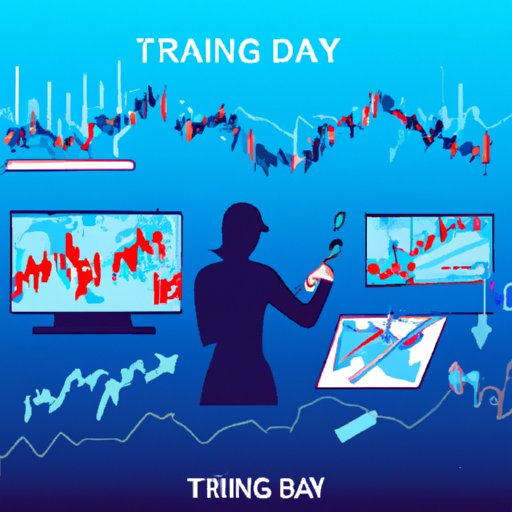
Introduction
Day trading can be a thrilling and potentially lucrative activity for those willing to take on the risks involved. Day traders buy and sell stocks, forex, or other financial instruments in a single day, hoping to profit from short-term price movements. However, it can be a challenge for beginners to navigate the complexities of the markets and execute profitable trades consistently.
In this article, we will provide a beginner’s guide to day trading, including tips and tricks for success, various day trading strategies, the benefits and risks of day trading, how to set day trading goals and build a plan, the best tools and platforms for day trading and technical analysis, and how to manage risk and navigate volatility in day trading. Whether you’re just starting or looking to improve your existing skills, this guide will provide essential information and practical advice to help you succeed as a day trader.
Beginner’s Guide to Day Trading: Tips and Tricks for Success
The first step to successful day trading is understanding what it is and how it differs from other types of trading. Day trading is a form of speculative trading, and it involves buying and selling financial instruments, such as stocks or forex, within the same day. The goal is to profit from small price movements in the short term.
For beginners, it’s essential to start with a small account and only trade with money you can afford to lose. It’s also important to stick to a strategy and have a good understanding of the markets you’re trading. Using stop-loss orders can also help limit your losses and protect your capital.
Common mistakes that beginners make include overtrading, not having a clear trading plan, and letting emotions guide their decisions. To avoid these mistakes, focus on developing a sound trading strategy, setting realistic goals, and maintaining a disciplined and rational approach to trading.
Day Trading Strategies for Maximizing Profits
Successful day traders use various strategies to maximize their profits, including momentum trading, scalping, and swing trading. Momentum traders use technical analysis to identify stocks that are moving in a particular direction and try to enter trades at the right time to profit from those trends.
Scalpers try to profit from small price movements by buying and selling frequently throughout the trading day. Swing traders hold positions for several days or even weeks to profit from more significant price movements over time.
To identify stocks with high profit potential, day traders often rely on technical analysis tools such as moving averages, volume indicators, and oscillators. Risk management is also critical to successful day trading, and traders must limit their exposure to losses by using stop-loss orders, diversifying their trades and portfolios, and avoiding overtrading.
The Benefits and Risks of Day Trading
Day trading offers several potential benefits, including the potential for high profits, flexibility, and the ability to work from anywhere with an internet connection. However, it’s also important to recognize the risks involved, including significant losses, stress and emotional strain, and regulatory and tax considerations.
To manage these risks, it’s essential to choose a reliable broker, maintain a risk management strategy, and stay informed about regulatory changes and tax implications. It’s also essential to avoid overtrading, maintain a disciplined approach to trading, and always be prepared for unexpected market moves.
Setting Day Trading Goals and Building a Plan
Before starting to day trade, it’s essential to set clear goals and develop a solid trading plan. Your goals should be specific, measurable, achievable, relevant, and time-bound (SMART), and they should align with your financial and lifestyle objectives.
Developing a trading plan involves determining your risk tolerance, selecting a trading strategy, establishing entry and exit points, and setting rules for portfolio management. Regularly reviewing and adjusting your plan based on your progress and market conditions is also essential.
Day Trading Tools and Platforms: A Comprehensive Guide
Various tools and platforms are available to day traders to help them make informed trading decisions and execute trades efficiently. These include charting software, trading platforms, news and research sources, and technical analysis tools and indicators.
The key to choosing the best tools for your trading style and goals is to research and compare the available options carefully. Factors to consider when selecting a platform include ease of use, cost, reliability, features, and customer support.
Mastering Technical Analysis for Day Trading
Technical analysis is a critical skill for day traders, as it enables them to analyze market trends and price movements and make informed trading decisions. Common tools and techniques used in technical analysis include moving averages, candlestick charts, and relative strength index (RSI).
To master technical analysis, it’s essential to study and practice using these tools and techniques regularly. It’s also important to stay up to date with market news and trends and maintain a disciplined approach to trading.

Managing Risk and Navigating Volatility in Day Trading
Managing risk and navigating volatility are critical to success in day trading. Some common strategies for managing risk include using stop-loss orders, diversifying trades and portfolios, and avoiding overtrading. It’s also essential to stay informed about market news and events that may impact your trades and adjust your positions accordingly.
In times of high volatility, it’s essential to remain calm and avoid making emotional decisions. Maintaining a disciplined and rational approach to trading, even in challenging market conditions, is key to long-term success in day trading.
Conclusion
Day trading can be a challenging and potentially rewarding activity for those who are willing to take on the risks involved. To succeed as a day trader, it’s essential to develop a sound trading strategy, set realistic goals, and maintain a disciplined and rational approach to trading. By following the tips and practical advice outlined in this article, beginners can increase their chances of success and achieve their day trading objectives.
Remember that day trading involves significant risks and is not suitable for everyone. Always consult with a financial advisor before making any investment decisions, and never invest more than you can afford to lose. With the right mindset, tools, and strategies, day trading can be a potentially lucrative and fulfilling activity.




